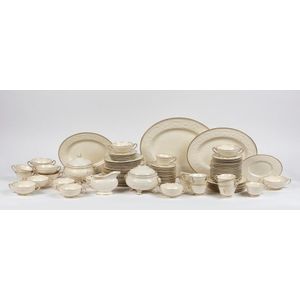Gilded Wedgwood Creamware Dinner Set for 12
You must be a subscriber, and be logged in to view price and dealer details.
Subscribe Now to view actual auction price for this item
When you subscribe, you have the option of setting the currency in which to display prices to $Au, $US, $NZ or Stg.
- Etruria - The Etruria Works was one of the ceramics factories opened by Josiah Wedgwood in 1769 on the Ridge House Estate in a district of Stoke-on-Trent, Staffordshire, England, which he named Etruria. The source of the name was from that given to Greek vases which at that time were thought to be from Etruria in Italy, the source of Etruscan ceramics. The factory ran for 180 years, as part of the wider Wedgwood business.
- Embossed / Repousse - Embossing, also known as repousse, is the technique of decorating metal with raised designs, by pressing or beating out the design from the reverse side of the object.It is the opposite of chasing, where the decoration is applied from the front. An embossed or repoussed object may have chasing applied to finish off the design.
- Creamware - Creamware, also known as "Queens Ware" is the
cream-coloured English earthenware developed by Josiah Wedgwood in the 1760s.
The invention of creamware was the result of experimentation in order to find a
British substitute for imported Chinese porcelain, and the cream colour was
considered a fault at the time. The lightweight fine white earthenware with a
clean rich yellowish proved ideal for tableware
and decorative items during the 18th and 19th centuries and is still produced
today.
Creamware is made from a
mixture of kaolin, feldspar, and ball clay, and is typically glazed before
firing to give it its glossy finish. It was developed by British potters as a
cheaper alternative to porcelain.
At Wedgwood, Royal patronage
boosted sales. In 1765 Queen Charlotte, the consort of King George III placed
an order for a 12 place tea set and allowed Wedgwood to use the name
"Queens Ware" for the line. In 1770 Wedgwood produced a creamware
dinner service of 952 pieces supplied to Catherine II the Great of Russia.
Other potteries such as
Doulton, Neale & Co. and Spode produced smaller quantities of creamware.
Creamware continued to be
made throughout the 19th century and later. - Gilding - Gilding is a method of ornamentation whereby a thin sheet of gold metal is applied to items made of wood, leather, ceramics, glass and silver for decorative purposes.
For furniture including mirrors, the sheet of gold is usually applied over a coating of gesso. Gesso is a mixture of plaster of Paris and gypsum mixed with water and then applied to the carved wooden frames of mirrors and picture frames as a base for applying the gold leaf. After numerous coats of gesso have been applied, allowed to dry and then sanded a coat of "bole", a usually red coloured mixture of clay and glue is brushed on and allowed to dry, after which the gold leaf is applied. Over time parts of the gilding will rub off so the base colour can be seen. In water gilding, this was generally a blue colour, while in oil gilding, the under layer was often yellow. In Victorian times, gilders frequently used red as a pigment beneath the gold leaf.
Metal was often gilded by a process known as fire gilding. Gold mixed with mercury was applied and heated, causing the mercury to evaporate, the long-term effect of which was to kill or disable the craftsman or woman from mercury poisoning. The pursuit of beauty has claimed many victims, not the least of which were the artists who made those pieces so highly sought after today.
This item has been included into following indexes:
- Wedgwood (England), item types
Visually similar items

58 piece Wedgwood gold Columbia dinner set. Sage green pattern. Settings for 6, including teapot, creamer and sugar bowl.

A part set of Rene Lalique green stained 'Poully' dinner ware, model introduced 1931, acid etched R. Lalique, France, Marcilhac no. 5226, the plate 22 cm diameter

A Royal Doulton Rochelle pattern dinner service for twelve including; 11 dinner plates, 12 fish plates, 11 soup bowls, 12 side plates, 11 tea cups, 7 saucers, one large serving platter, one medium serving platter, one medium serving bowl, marked 'Rochelle

A Susie Cooper 'Glen Mist' dinner set for six (51), six each dinner, entree and side plates, bowls, coffee cups and saucers, tea cups and saucers, a sugar and creamer and tea pot (AF). Fifty-one pieces in total.
